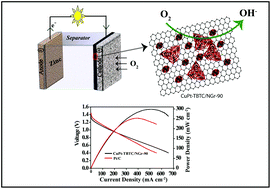Nitrogen-doped graphene anchored with mixed growth patterns of CuPt alloy nanoparticles as a highly efficient and durable electrocatalyst for the oxygen reduction reaction in an alkaline medium†
Abstract
A highly active and durable CuPt alloy catalyst with trigonal bipyramidal and truncated cube-type mixed morphologies, anchored on the nitrogen-doped graphene (NGr) surface (CuPt-TBTC/NGr), was prepared by a simple and fast method. The obtained CuPt alloy showed improved oxygen reduction reaction (ORR) activity, with a 30 mV positive shift in the half-wave potential value, as compared to the state-of-the-art Pt/C catalyst in a 0.1 M KOH solution. The CuPt alloy with the trigonal bipyramidal morphology possesses porous type inter-connected sides, which help to achieve improved mass transport of oxygen during the ORR. The exposure of the (111) plane of the CuPt alloy further improved the catalytic activity towards the dioxygen reduction in alkaline media. The ORR activity of the NGr-supported CuPt alloy was found to be dependent on the reaction time, and improved activity was obtained on the material derived at a reaction time of 90 min (CuPt-TBTC/NGr-90). The material synthesized at a lower or higher reaction time than 90 min resulted in a partially formed trigonal bipyramidal morphology with more truncated cubes or agglomerated trigonal bipyramidal and truncated cubes with closed type structures, respectively. Along with the high intrinsic ORR activity, CuPt-TBTC/NGr-90 displayed excellent electrochemical stability. Even after repeated 1000 potential cycling in a window ranging from 0.10 to 1.0 V (vs. RHE), the system clearly outperformed the state-of-the-art Pt/C catalyst with 15 and 60 mV positive shifts in the onset and half-wave potentials, respectively. CuPt-TBTC/NGr-90 also exhibited 2.1 times higher mass activity and 2.2 times higher specific activity, compared to Pt/C at 0.90 V (vs. RHE). Finally, a zinc–air battery fabricated with the alloy catalyst as the air electrode displayed a peak power density of 300 mW cm−2, which is much higher than the peak power density of 253 mW cm−2 obtained for the state-of-the-art Pt/C catalyst as the air electrode.



 Please wait while we load your content...
Please wait while we load your content...